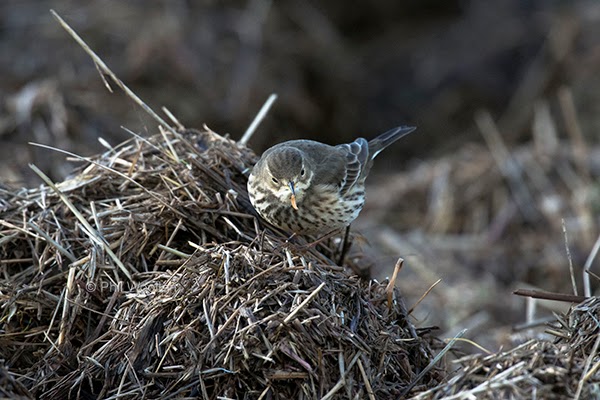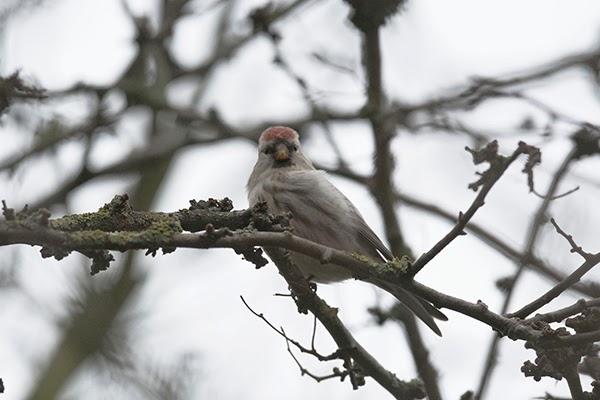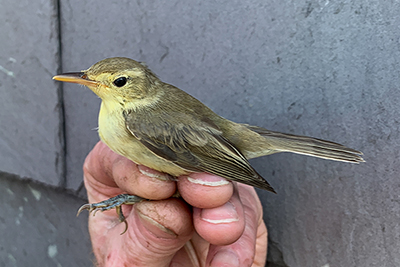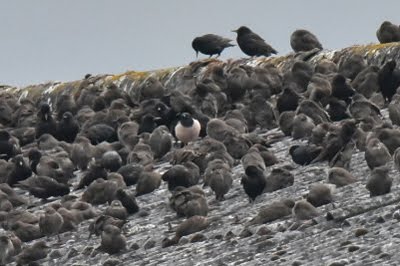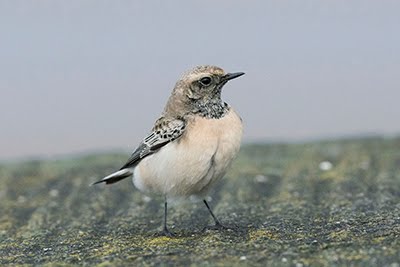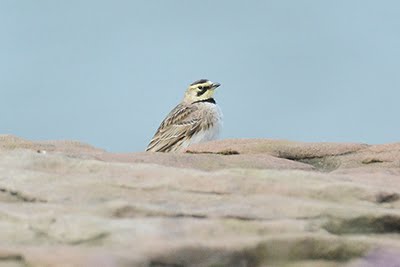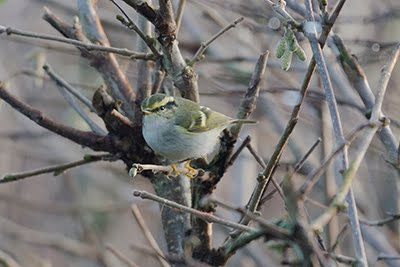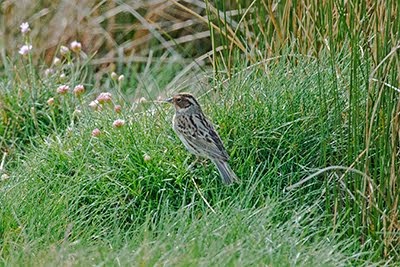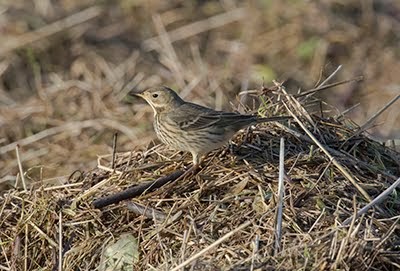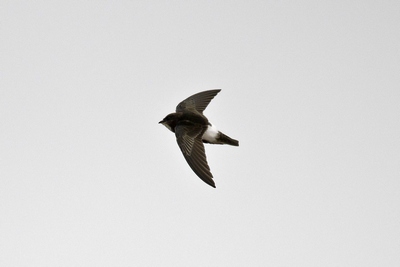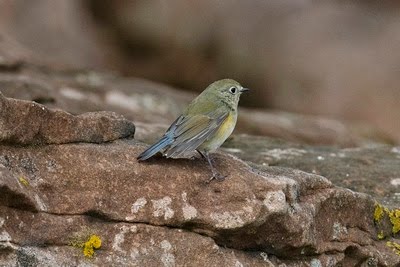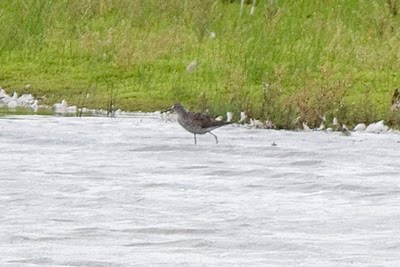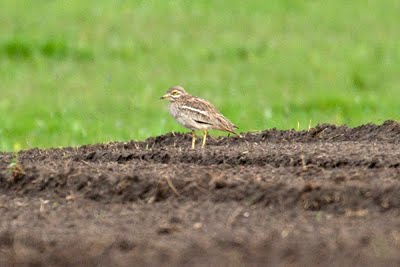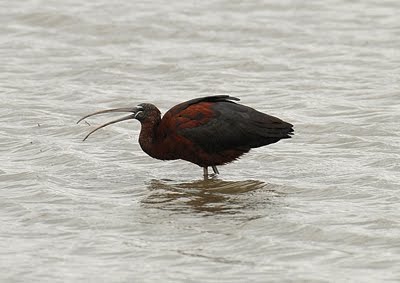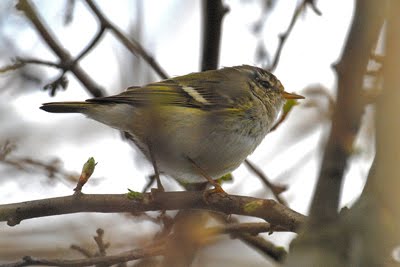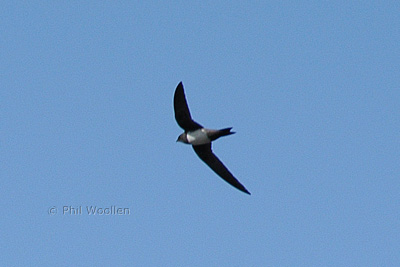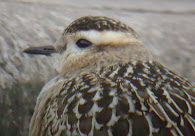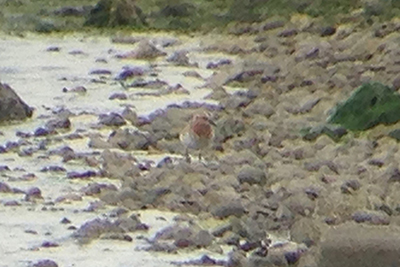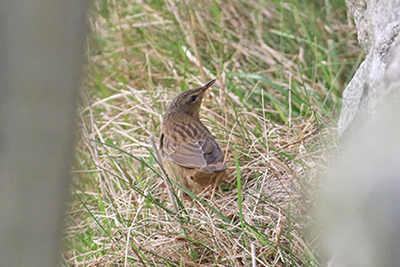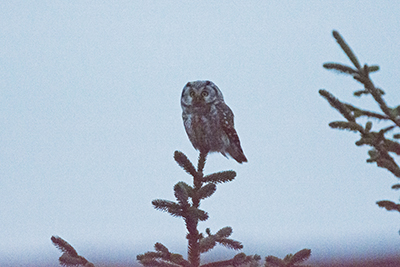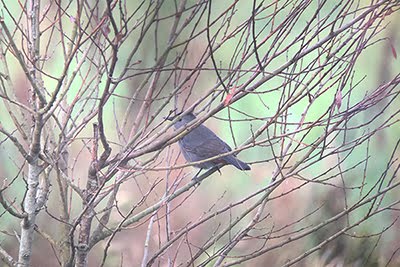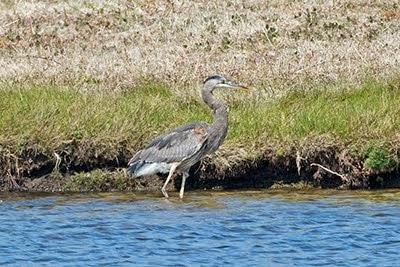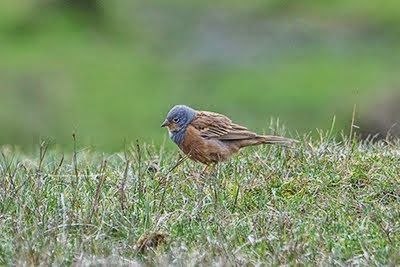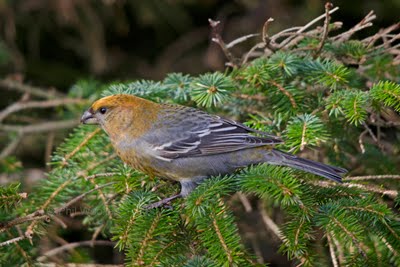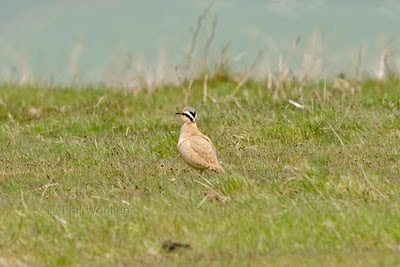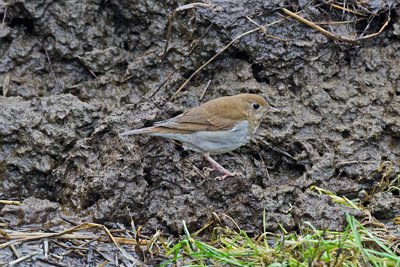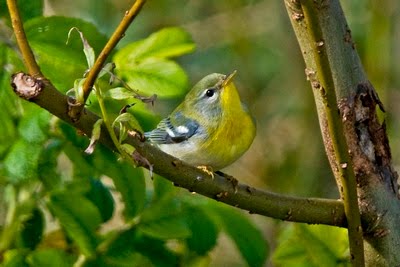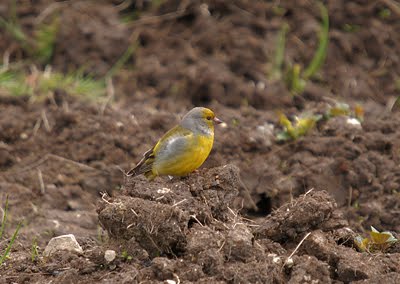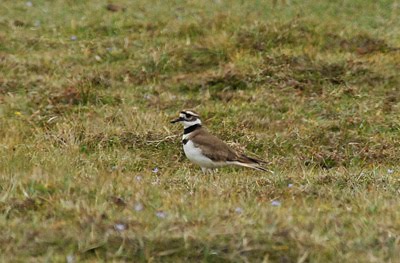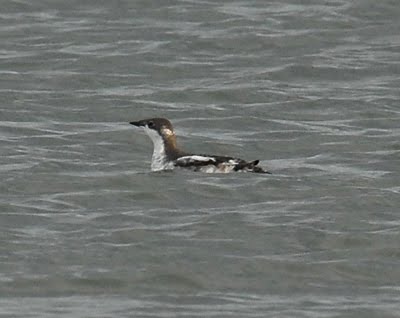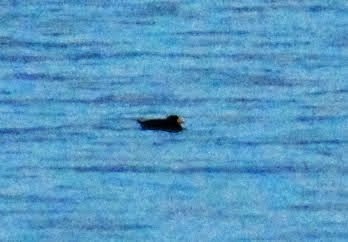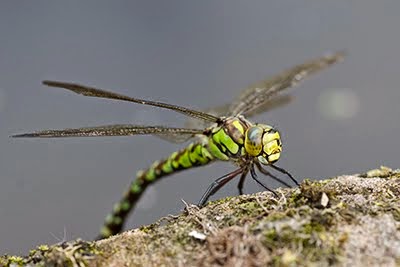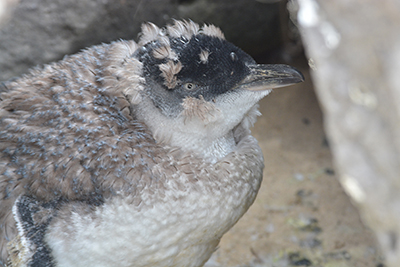Following on from the possible Coue's Arctic I've had a mealy visit the garden on and off for the past week. I even managed to get a couple of photographs through the kitchen window:
There's also been another possible candidate and at least 4 different lesser Redpolls seen on the feeders together.
Here's a Lesser for comparison:
With Steve calling in for a brew and the Mealy again being seen on the feeders we decided to put a mist net up in the garden for a short while (whilst the weather was calm and the rain had at last stopped). One of the first birds we caught was a Mealy and we soon had a Lesser to compare it with. The Lesser had a wing length of 68 mm whilst the Mealy was a stonking 77 mm.
We aged it as a 2nd calendar year bird as there was an obvious moult contrast in the greater coverts and the tail looks typically pointed. The undertail coverts were quite streaked but the streaking was dull.
There was possibly a faint pink tinge to the cheek coverts suggesting a young male but we left it un-sexed.
Finally here's a selection of photos Steve took showing comparison with the Lesser Redpoll.
Note how my hand holding the Lesser is blue with cold.......................
Redpolls, I love em.
31 Jan 2014
28 Jan 2014
Get in!
Tweeted last night by BBRC:
Story here:
http://wirralbirders.blogspot.co.uk/2013/08/its-fking-feas.html
We were lucky - right place at the right time.
@_BBRC: #BBRCdecision :Ref No 4647 Accepted-Fea�s/Zino's Petrel (group)
14-August-13 Gwennap Head, Porthgwarra,Cornwall
Story here:
http://wirralbirders.blogspot.co.uk/2013/08/its-fking-feas.html
We were lucky - right place at the right time.
27 Jan 2014
Redwing!
We had a ringing session at Barry's a few weeks ago and I'd forgotten about the photo's I'd taken of the Redwing we'd caught. They really are beautiful little birds & a species I haven't ringed very often!
This was the first time we'd caught Redwings in Barry's garden and we managed an adult and a 1st year bird. 1st year birds are identified by the white tips to the tertials that ca nbe clearly seen in this photo below.
The shape of the tail feathers is also a giveaway.
Adults don't have these white tips and check out the tail feathers.
With a good variety of species and a 105 birds caught it was good experience for Scott and kept us busy. Amongst the other interesting birds was this Dunnock. Dunnock & interesting in the same sentence?
This one was as it is the only one I can remember showing a very clear distinction between the retained juvenile greater coverts and the new adult type following its post juvenile moult.
All in all another great session and many thanks to Barry for the use of his shed and providing the tea.
Scott & John in the shed of dreams
The shape of the tail feathers is also a giveaway.
Adults don't have these white tips and check out the tail feathers.
With a good variety of species and a 105 birds caught it was good experience for Scott and kept us busy. Amongst the other interesting birds was this Dunnock. Dunnock & interesting in the same sentence?
This one was as it is the only one I can remember showing a very clear distinction between the retained juvenile greater coverts and the new adult type following its post juvenile moult.
All in all another great session and many thanks to Barry for the use of his shed and providing the tea.
24 Jan 2014
Seconds on the Buff-bellied Pipit
I managed another look at Burton Marshes most famous current resident recently - the Buff-bellied Pipit!
Sitting in the Landrover I spotted the bird fairly quickly and waited for the bird to come to me rather than chasing it up and down the fence line as a couple of others seemed to be doing. There is no need to clamber down the bank and follow it up and down,. Be patient and it will come to you.
A cracking little bird that looks as if its moulted its largest tertial (T3).
Its a strange looking bird and not as buff as others I've seen over the years. It was nice to catch up with Eddie & Kenny D there as well. The lads are on a roll at the moment - they found an adult Iceland Gull on the Gowy tip last weekend to compliment the juvenile I found between Christmas & New year.
Sitting in the Landrover I spotted the bird fairly quickly and waited for the bird to come to me rather than chasing it up and down the fence line as a couple of others seemed to be doing. There is no need to clamber down the bank and follow it up and down,. Be patient and it will come to you.
A cracking little bird that looks as if its moulted its largest tertial (T3).
Its a strange looking bird and not as buff as others I've seen over the years. It was nice to catch up with Eddie & Kenny D there as well. The lads are on a roll at the moment - they found an adult Iceland Gull on the Gowy tip last weekend to compliment the juvenile I found between Christmas & New year.
20 Jan 2014
More Redpolls and SCAN ringing trip
After my possible Arctic Redpoll of 12th January low and behold a possible Hornemann's has been visiting a garden near Chester, probably only 5-6 miles away, for 5 days...........I'm pretty sure this is a different bird though as mine didn't appear large enough for a Hornemann's and appears to have more flank streaking.
After completing the jobs assigned to me Sunday morning I decided to stick a mist net up in the garden for a couple of hours in the hope of catching a few finches. Unbelievably the first bird extracted was a control adult male Lesser Redpoll!
This bird had very clean undertail (utc) coverts with one obvious streak on the longest utc.
Awhile later I caught another adult male (Euring 6) and this bird had a lot more streaking on its utc's.
It just goes to show the variability in this feature and how it shouldn't be relied on to differentiate between races / species! Both birds were males of the same minimum age i.e definitely born before last year but exact age unknown.
Saturday was a SCAN cannon netting session and despite the awful weather at 05.30 when I got up the weather did improve enough to not be to uncomfortable. Although we didn't catch the Dunlin we'd planned for the 'fall back' net produced the goods with a small catch of Shelduck & Wigeon. Both species I'd not ringed previously so I was chuffed to get this opportunity and learn something new about ageing these birds.
The photo below shows the wing of the adult male Shelduck I'm holding above. It's aged as an adult as the greater coverts are clean white with no dark markings on the tips. Besides the obvious bill protrusions it can be sexed as a male by the clean chestnut collar with little or no speckling between the chestnut and white colouration.
Whereas the 5 male below has some indistinct grey tips to the inner most greater coverts by Steve's thumb.
After completing the jobs assigned to me Sunday morning I decided to stick a mist net up in the garden for a couple of hours in the hope of catching a few finches. Unbelievably the first bird extracted was a control adult male Lesser Redpoll!
This bird had very clean undertail (utc) coverts with one obvious streak on the longest utc.
Awhile later I caught another adult male (Euring 6) and this bird had a lot more streaking on its utc's.
It just goes to show the variability in this feature and how it shouldn't be relied on to differentiate between races / species! Both birds were males of the same minimum age i.e definitely born before last year but exact age unknown.
Saturday was a SCAN cannon netting session and despite the awful weather at 05.30 when I got up the weather did improve enough to not be to uncomfortable. Although we didn't catch the Dunlin we'd planned for the 'fall back' net produced the goods with a small catch of Shelduck & Wigeon. Both species I'd not ringed previously so I was chuffed to get this opportunity and learn something new about ageing these birds.
The photo below shows the wing of the adult male Shelduck I'm holding above. It's aged as an adult as the greater coverts are clean white with no dark markings on the tips. Besides the obvious bill protrusions it can be sexed as a male by the clean chestnut collar with little or no speckling between the chestnut and white colouration.
Whereas the 5 male below has some indistinct grey tips to the inner most greater coverts by Steve's thumb.
All in all a great weekend with a recce of other nearby sites looking for the elusive Dunlin resulting in two Great Northern Divers and a winter plumaged Black Guillemot off Bangor Pier and a Long-tailed Duck out in the bay.
14 Jan 2014
Common Redpoll or something much tastier?
Last Sunday I returned from my footit campaign to try and nail the Stanney Woods Lesser spotted Woodpecker feeling a bit despondent about the lack of good birds -especially finches! Not a single Redpoll or Brambling so far this January.
Making a brew and retiring to the conservatory I noticed a male Lesser Redpoll on the sunflower heart feeders. It was a nice pink bird so I grabbed the camera and snuck around the outside of the conservatory to get a photo. It flew off the feeders into the nearby hawthorn and as my gaze moved upwards I was stunned to see a ghostly pale Redpoll with its back towards me showing a gleaming white rump. I didn't have my binoculars with me so couldn't determine if the bird had any streaking on the rump - if it did it was very faint - or any undertail covert streaking. At this point I was cautiously moving to try and get an un-obscured shot. There were Greenfinches, Chaffinches and Goldfinches in the same bush & I estimated the bird to be about Goldfinch size but much plumper and more fluffed up.
Unfortunately the whole flock was disturbed by kids playing in the trees surrounding the pond adjacent to our garden and the whole flock flew off. It was only after viewing the photos on the back of the camera I noticed the small bill and punched in looking face reminiscent of Arctic Redpoll. Shit!
Taking a few photos with my mobile off the back of the camera I forwarded them to a few birding friends. The responses were understandably cautious but reinforced my own concerns.
Despite a 3 hour vigil in the warmth of the conservatory with camera and binoculars at hands and only cups of tea and a tin of Christmas leftover chocolate biscuits to console me neither Redpolls reappeared.
Here are the best photographs I managed to salvage:
And the worst:
So what do the photos tell me?
Fortunately there was a big article on Redpoll identification in British Birds December 2013 bt Andy Stoddard. Current thinking is there 6 type's of Redpoll - Carduelis cabaret (Lesser Redpoll - the little brown jobs), C flammea (Common or Mealy Redpoll) of which there are possibly three recognised races. C f flammea (nominate), C f. rostrata (so called Greenland Redpoll) & C f. icelandica (pale Icelandic Redpoll). In addition there is the Arctic Redpoll complex with the most desirable being the 'snowball' Carduelis hornemanni and the more subtle Carduelis h exilpes or Coues's Arctic Redpoll.
From the photographs I think I can safely rule out Greenland, Lesser Redpoll and Hornemanns Arctic Redpoll which leaves three possibilities - a very white and frosty Mealy, Coue's Arctic or pale Icelandic.
Pale Icelandic rostrata is a much bigger bird similar to the more familiar dark Greenland birds I've seen on Shetland regularly. These are real brusiers whereas my bird looks quite dinky and cute faced.
There is an overlap in wing lengths between Mealy & Coue's Arctic Redpoll so nothing can be determined by this although my bird does seem to be long winged. There is huge variability in the amount of flank and rump streaking depending on age. Even undertail covert streaking is variable but unfortunately its virtually impossible to make out the undertail coverts from my photo' although the 2nd photo down might show a single dark central streak.
According to BWP 1st winter male Arctic Redpoll can show a single central streak on the undertail coverts.
The BB article also says Coue's Arctic Redpoll is long tailed. I think the photo's clearly show this bird to have a long tail! The same article says, due to the dense feathering, Arctic Redpolls appear fluffed up and always appear to have difficulty covering their rumps with their wings. My bird certainly looks fluffed up and you can imagine the rump being visible if it turned round - exactly as it was when I first spotted it.....
I keep coming back to that cute little face, short bill and bull necked appearance. Another interesting biometric in the BB article is that Coue's, although having a short bill has a very broad base to it. Look at the head on shot above.
Below is a Coue's I photographed at Baltasound, Unst about three years ago.
Note how wet the bird is so the feathering around the bill is flattened making the bill look longer
Here's a Mealy photographed at the same time.
And a Mealy caught and ringed in my garden last year with a massive great conk.
One of the characteristics of Arctic Redpoll is the dense feathering and the fact the bill looks shorter due to the feathering around the base:
Gulp!
Another feature I've read about recently is the straight culmen.....
So a very pale Mealy or a Coue's Arctic Redpoll?
My heart is saying this is the one that got away. If it comes back I'll hopefully get better views and better photographs.
Making a brew and retiring to the conservatory I noticed a male Lesser Redpoll on the sunflower heart feeders. It was a nice pink bird so I grabbed the camera and snuck around the outside of the conservatory to get a photo. It flew off the feeders into the nearby hawthorn and as my gaze moved upwards I was stunned to see a ghostly pale Redpoll with its back towards me showing a gleaming white rump. I didn't have my binoculars with me so couldn't determine if the bird had any streaking on the rump - if it did it was very faint - or any undertail covert streaking. At this point I was cautiously moving to try and get an un-obscured shot. There were Greenfinches, Chaffinches and Goldfinches in the same bush & I estimated the bird to be about Goldfinch size but much plumper and more fluffed up.
Unfortunately the whole flock was disturbed by kids playing in the trees surrounding the pond adjacent to our garden and the whole flock flew off. It was only after viewing the photos on the back of the camera I noticed the small bill and punched in looking face reminiscent of Arctic Redpoll. Shit!
Taking a few photos with my mobile off the back of the camera I forwarded them to a few birding friends. The responses were understandably cautious but reinforced my own concerns.
Despite a 3 hour vigil in the warmth of the conservatory with camera and binoculars at hands and only cups of tea and a tin of Christmas leftover chocolate biscuits to console me neither Redpolls reappeared.
Here are the best photographs I managed to salvage:
And the worst:
So what do the photos tell me?
Fortunately there was a big article on Redpoll identification in British Birds December 2013 bt Andy Stoddard. Current thinking is there 6 type's of Redpoll - Carduelis cabaret (Lesser Redpoll - the little brown jobs), C flammea (Common or Mealy Redpoll) of which there are possibly three recognised races. C f flammea (nominate), C f. rostrata (so called Greenland Redpoll) & C f. icelandica (pale Icelandic Redpoll). In addition there is the Arctic Redpoll complex with the most desirable being the 'snowball' Carduelis hornemanni and the more subtle Carduelis h exilpes or Coues's Arctic Redpoll.
From the photographs I think I can safely rule out Greenland, Lesser Redpoll and Hornemanns Arctic Redpoll which leaves three possibilities - a very white and frosty Mealy, Coue's Arctic or pale Icelandic.
Pale Icelandic rostrata is a much bigger bird similar to the more familiar dark Greenland birds I've seen on Shetland regularly. These are real brusiers whereas my bird looks quite dinky and cute faced.
There is an overlap in wing lengths between Mealy & Coue's Arctic Redpoll so nothing can be determined by this although my bird does seem to be long winged. There is huge variability in the amount of flank and rump streaking depending on age. Even undertail covert streaking is variable but unfortunately its virtually impossible to make out the undertail coverts from my photo' although the 2nd photo down might show a single dark central streak.
According to BWP 1st winter male Arctic Redpoll can show a single central streak on the undertail coverts.
The BB article also says Coue's Arctic Redpoll is long tailed. I think the photo's clearly show this bird to have a long tail! The same article says, due to the dense feathering, Arctic Redpolls appear fluffed up and always appear to have difficulty covering their rumps with their wings. My bird certainly looks fluffed up and you can imagine the rump being visible if it turned round - exactly as it was when I first spotted it.....
I keep coming back to that cute little face, short bill and bull necked appearance. Another interesting biometric in the BB article is that Coue's, although having a short bill has a very broad base to it. Look at the head on shot above.
Below is a Coue's I photographed at Baltasound, Unst about three years ago.
Note how wet the bird is so the feathering around the bill is flattened making the bill look longer
Here's a Mealy photographed at the same time.
And a Mealy caught and ringed in my garden last year with a massive great conk.
One of the characteristics of Arctic Redpoll is the dense feathering and the fact the bill looks shorter due to the feathering around the base:
Gulp!
Another feature I've read about recently is the straight culmen.....
So a very pale Mealy or a Coue's Arctic Redpoll?
My heart is saying this is the one that got away. If it comes back I'll hopefully get better views and better photographs.
Subscribe to:
Posts
(
Atom
)


























